Epidote is a silicate mineral commonly found in regionally metamorphosed rocks of low-to-moderate grades. Within these rocks, Epidote is frequently associated with amphiboles, Quartz, chlorite, and Feldspars. It occurs as replacements of mineral grains altered by metamorphism.
You’ll typically find Epidote as an inclusion in a host mineral. For example, the Quartz crystal below is a great example. As you can see the Epidote crystals have grown around and inside the crystal which makes for a great specimen. You can find specimens with Epidote crystals only but they’re not as common.
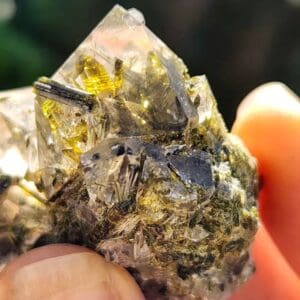
How To Identify Epidote
Epidote is characterized by its peculiar green color and its single perfect cleavage.
Let’s start with color. Epidote is usually yellowish green to pistachio green. However, sometimes it can be brownish green to black. Of course, there are numerous stones and crystals sporting the same colors, like Schrol Tourmaline.
Performing a streak test can be of help. Epidote produces a colorless streak, so if the colors align and there is no streak color so far, you’re on the right track.
Looking at the luster of the specimen, if it is Epidote, it should have a vitreous to resinous luster. The diaphaneity isn’t as easily detectable as Epidote and can be transparent from translucent to nearly opaque. However, the stone has perfect cleavage in one direction.
Checking the hardness of your specimen will also provide some clues to its identity. Epidote is a 6 to 7 on the Mohs hardness scale, meaning it’s harder to scratch with your fingernail.
The magnet test might offer a clue as to whether your specimen is epidote or not. Because the stone is iron-rich, it can be somewhat attracted to magnets.
This guide on How To Identify Rocks and Minerals will provide an in-depth look at the techniques you can use to correctly identify any rock, crystal, or mineral.
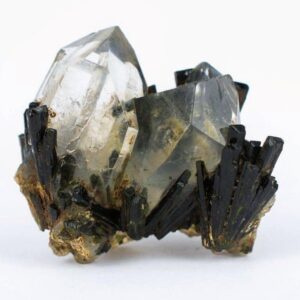
What Is Epidote Quartz?
Epidote is a calcium aluminum iron borosilicate mineral. It occurs in nature as prismatic rod-like green-colored crystals and when these beautiful grass-green crystals are present in colorless transparent Quartz, they form a fascinating and complex pattern. Fine specimens of epidote quartz are highly prized by collectors.
Epidote is a metamorphic rock primarily composed of epidote containing small amounts of quartz. It forms when ophiolites and basalts in sheeted dikes are transformed by metasomatism or hydrothermal activity.
Unakite is a stone that forms from the metamorphism of granite. Less resistant minerals within the granite become altered to be transformed into Epidote or replaced completely by Epidote, with the Orthoclase and Quartz remaining.
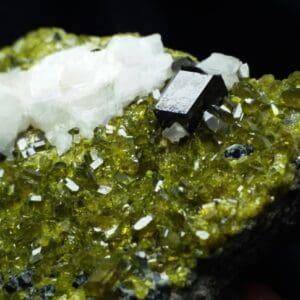
Green Epidote
Epidote crystals typically range between yellowish green to pistachio green in color. However, less often, brownish-green to black-colored specimens can be found. Epidote, in massive form, is usually translucent with a vitreous luster. At the same time, well-formed crystals from pegmatite and marble are often transparent.
Epidote is a rock-forming mineral, and many regionally metamorphosed rocks contain small amounts. Two rock types containing significant amounts of Epidote are Unakite and Epidosite.
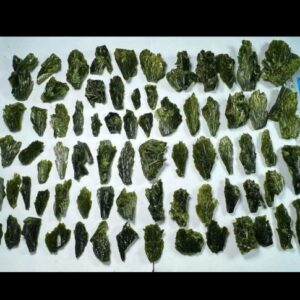
Where Is Epidote Found?
Epidote can be found across the world but if you live in the United States then you’re in luck because you can find it in almost every state. Here’s a short list of the states where Epidote is easily found and collected.
Alabama, Alaska, Arizona, Arkansas, California, Colorado, Connecticut, Florida, Georgia, Hawaii, Idaho, Indiana, Iowa, Maine, Maryland, Massachusetts, Michigan, Minnesota, Missouri, Montana, Nevada, New Hampshire, New Jersey, New Mexico, New York, North Carolina, Oklahoma, Oregon, Pennsylvania, Puerto Rico, Rhode Island, South Carolina, Soth Dakota, Tennessee, Texas, Utah, Vermont, Virginia, Washington, West Virginia, Wisconsin, Wyoming.
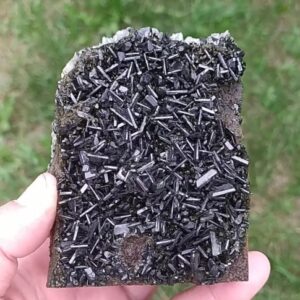
Epidote Luster
Luster is used to help identify rocks and minerals because it is easily observable. Epidote has a vitreous to resinous luster.
Epidote Thin Section
Epidote can generally be characterized by its prismatic habit with six-sided ‘basal’ sections. The stone has a single set of cleavage planes oriented parallel to the long axis. Under plane-polarized light, Epidote commonly displays greenish to greenish-yellow hues, often appearing very pale. The stone’s pleochroism can be subtle or barely detectable in the latter case. Whereas colored Epidote varieties naturally exhibit stronger colorless to pale yellow to yellow/green pleochroism.
Another diagnostic feature of Epidote is the high relief. At crossed polars, Epidote displays incredibly high interference colors, which vary significantly along the clinozoiste (Epidote series). Because of this, individual Epidote crystals often display a wide range of interference colors in the function of their internal chemical zoning, and they’re commonly described as being Harlequin-like.
Epidote’s birefringence is higher, close to the ferric ion, rich end member, and it decreases dramatically towards the clinozoisite end member. Pure clinozoisite displays first-order gray/yellow interference colors. In contrast, intermediate Epidote compositions generally show second to third-order interference colors.
Epidote Pronunciation
Epidote can be tricky to pronounce but here is the easy way to pronounce it “eh-puh-dowt”
Raw Epidote
Raw specimens of Epidote can sometimes seem like a rock from outer space. The host rocks are typically rough and bumpy, with green epidote crystals shooting out of them. From a distance, Epidote host rocks can appear as if they have yellow moss growing on them.
- Identify Enstatite - March 12, 2024
- Identify Cerussite - March 3, 2024
- Identify Bytownite - February 18, 2024

2 Responses
I tried subscribing 2 times being told both times was unsuccessful.
Rachel – thanks for the update and I looked at the subscriber list and you’ve been added.
Check your email and spam filter. You should see a welcome email.
Let me know if you need anything